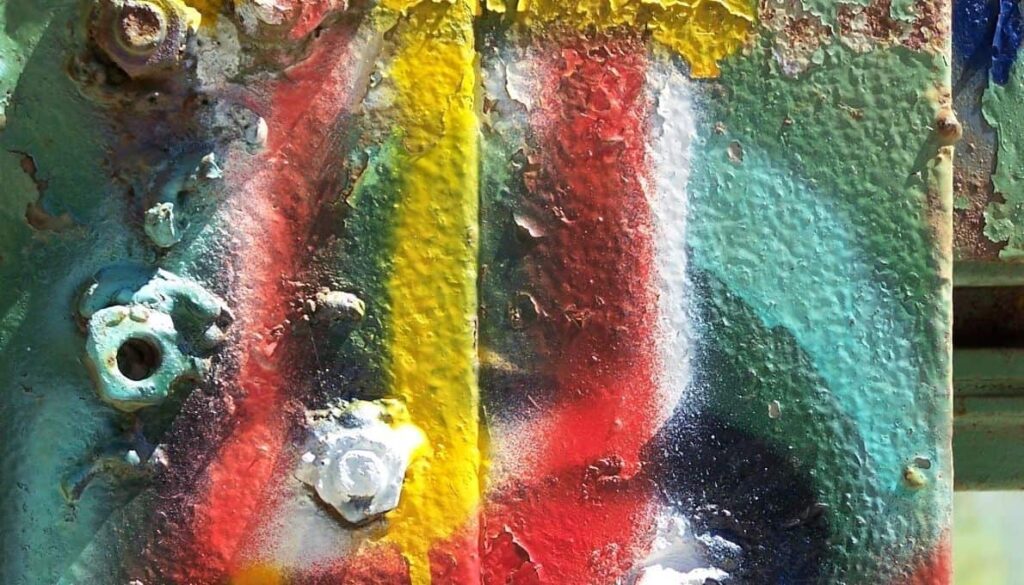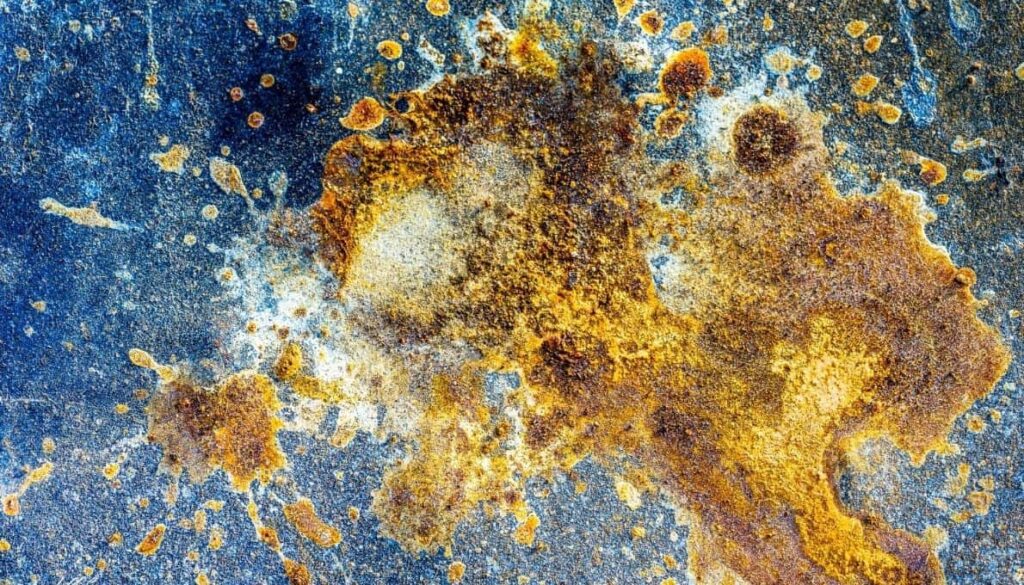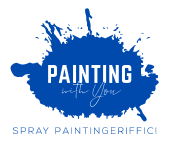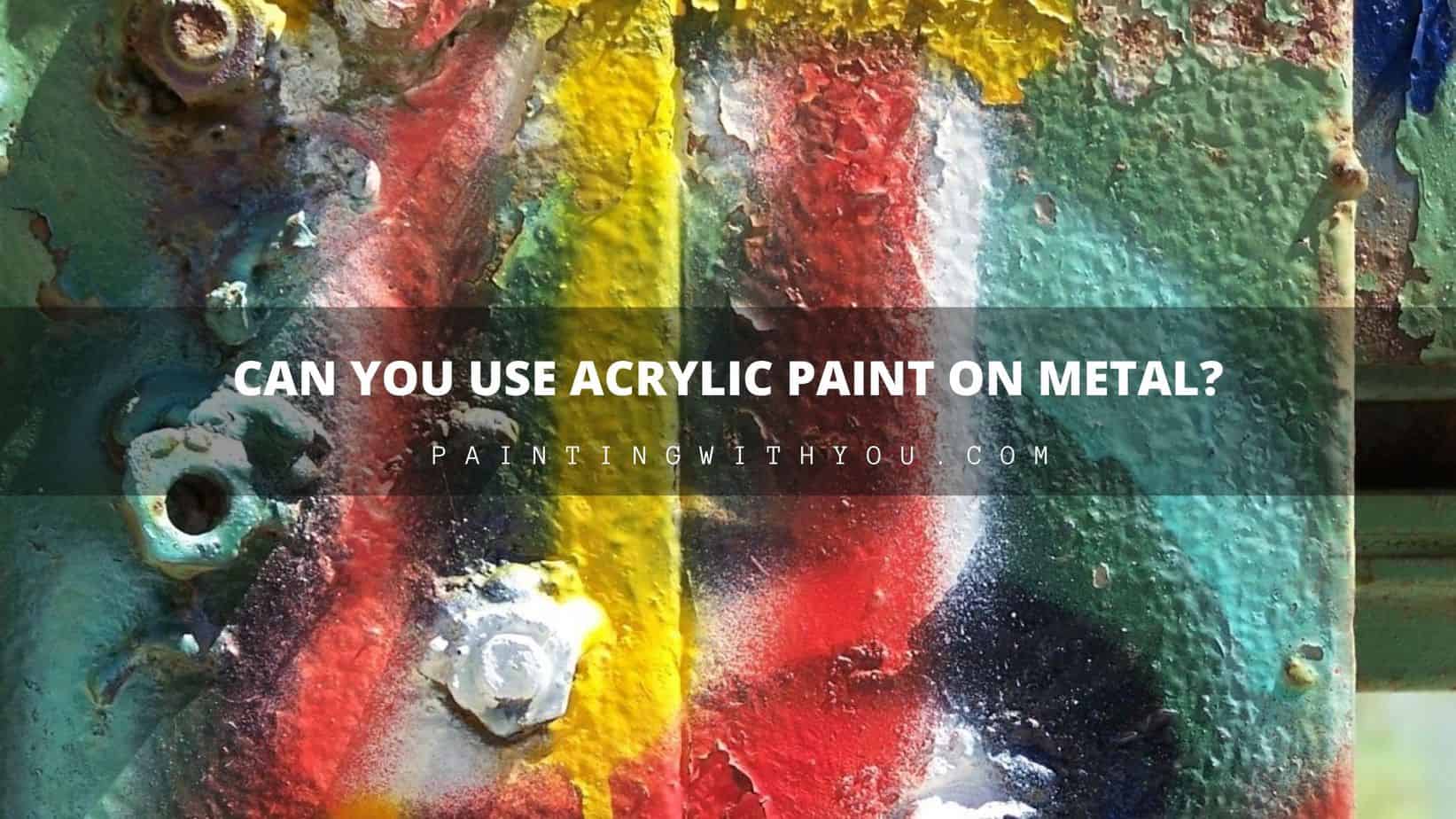Canvas is not the only surface used to display brilliant acrylic artwork. For a more dynamic way to display your art, consider branching out beyond your canvas to wood, walls, windows, or even acrylic paint on metal.
This article will outline everything you need to know to create a metal masterpiece.

Can you use acrylic paint on metal?
Acrylic Paint can be used on metal as well. Just like with most surfaces, painting acrylic on metal requires preparation.
Pick your metal surface, sand it, clean it, prime it, paint your design, and then seal it for lasting quality.
The main difference between metal and other painting surfaces is that you want to use stronger cleaning tools and a rust-resistant primer when painting on metal.
Each new surface you paint on comes with unique nuances to consider before you achieve the best paint job possible. Read on to see the specific considerations for acrylic paint on metal surfaces and what you can do to make your piece last a lifetime.
Can Acrylic Paint be Used on Metal?
Using acrylic paint on metal is possible, and there are a variety of projects you can use it for. These range from DIY home projects to mixed media art pieces and beyond. Whatever you are painting, the process of a successful paint job begins long before you touch Painting brush.
How to Prepare Metal Before Painting with Acrylic?
The amount of preparation you must do depends on your metal piece’s state. If you are working with a rusty piece of outdoor furniture, then you will need to clean it more than a fresh metal sheet from the art store.
Any overly rusty or dirty piece should be brushed off with a wire brush. This also removes any old paint on the object. Wipe off the dirt pieces with a wet rag as you go. Once you have gotten off as much dirt, paint, or rust as you can with the wire brush, use a piece of sandpaper to ensure every inch of the surface has been properly cleaned and scratched up. This will allow the paint to stick well.
Use acetone or mineral spirits to wipe the piece clean before you continue. Always make sure you are in a well-ventilated area when using chemical cleaners like mineral spirits.
Do I Need to Prime Metal before Painting It?
Primer is always a good idea if you want to protect the medium underneath the paint and have your paint stick better. The only reason you may not want to prime is if you want your design to appear directly on the surface of the metal or if you want the effects of aging and time to appear on your piece.
Use a rust-inhibiting and/or anti-corrosive metal primer to protect your piece from oxidization, which metal is very prone to. Primers come in various colors, even clear, so pick the shade most helpful for your project. Usually, white primer provides the best base for acrylic colors to appear most vibrant.
Primers also come in either spray-on or brush-on types. Typically spray-on primers are the easiest to use for painting metal.
Will Acrylic Paint Stick to Metal?
Yes! I can definitively say that acrylic paint sticks to metal beautifully when proper techniques are followed.
The key to success is understanding that metal on its own provides a smooth, non-porous surface that acrylic paint cannot easily penetrate. This differs from materials like canvas or wood that allow the paint to soak in for superior adhesion.
How to Paint on Metal With Acrylic?
Step 1: Prep the Area
Collect all your materials and have them ready, cleaned, and at hand. This includes drop cloths, wire brushes, sand paper, cleaners, multiple rags, paints, brushes, and a fan to help with drying.
Here are the key steps when prepping metal for acrylic painting:
- Clean thoroughly to remove any oil, grease, rust or existing paint
- Sand with fine grit sandpaper to create a roughened surface
- Wipe clean to remove any sanding debris and dust
- Apply 2-3 coats of primer to provide a grip for the acrylic paint
Step 2: Clean
First, you must clean any dirt, dust, or rust off your metal. Use a wire brush to scrape off as much rust and old paint as possible. You can then use sandpaper to scratch up and clean the smaller nooks and crannies.
Use a chemical cleaner like mineral spirits (in a well-ventilated area) to wipe everything down and ensure no residue is left that could prevent the paint from sticking. Let everything dry for at least an hour.
Step 3: Prime
Use a rust-resistant primer to ensure your paint adheres to the metal surface. At least two coats will provide the best coverage.
Primers serve several important purposes:
- Enhances paint adhesion – Grips surface so paint sticks
- Inhibits rust – Protects metal from oxidation
- Fills imperfections – Smooths uneven surfaces
- Uniform foundation – Provides a consistent base layer
OTHER TIPS: When selecting a primer, look for one made of metal and compatible with acrylic paint. Spray primers allow for a thin, even application. Apply 2-3 coats to fully dry each before adding the next. Once priming is complete, the metal surface is ready for acrylic painting.
Then, give the primer at least 24-48 hours to dry depending on your workspace’s heat, humidity, and airflow.
Step 4: Paint
Now for the fun part – applying the acrylic paint! There are a few techniques that can be used to achieve smooth, even coverage:
Brushing
- Use high-quality nylon or synthetic brushes
- Load brush evenly and tap off excess paint
- Apply paint in smooth, overlapping strokes
- Work from top to bottom on vertical surfaces
Rolling
- Use short-nap or foam rollers for smooth metal
- Pour the paint into a roller tray and evenly coat roller
- Roll paint slowly and evenly across the surface
- Avoid excess pressure to minimize drips
Spraying
- Hold the can 6-8 inches from the surface
- Apply light, even coats using sweeping motions
- Allow each coat to fully dry before adding more
- Use consistent spraying distance for a uniform look
No matter the technique, remember to apply thin, even coats and allow proper drying time between layers. This not only prevents drips but allows for proper curing.
Decide whether you want to spray paint an even coat of the same color, brush on a more detailed design, or combine both. Collect an outdoor and/or rust-resistant set of paints and create your masterpiece.
If you choose to use spray paint, it is important to make sure your workspace is well-ventilated. Start your spray a little bit before you are above the piece and then spray evenly and continuously to the end of that section.
It is important to start and stop the paint spray off the piece; otherwise, the paint will collect and may cause drips.
Let your paint dry for about a week before you apply your top coat.

Step 5: Seal
Water-Resistance and Durability of Acrylic Paint on Metal
As with all materials, you should seal your art to make sure it will last forever. You need to check first your surface is clean and dry before you apply a sealant to protect your piece from any rain or sunshine.
Unsealed acrylic paint on metal has moderate water resistance but may experience:
- Loss of adhesion if exposed to standing water
- Softening, wrinkling, or fading when wet
- Increased vulnerability to scratches and chips
A glossy sealant will also make it easier to wipe down your piece for any future cleaning you may do. A spray-on, glossy, and clear sealant is typically the best choice to protect your piece.
Once properly sealed, acrylic paint obtains water-resistant properties that allow it to withstand rain and other wet conditions. Sealing is critical for outdoor use.
Let the final coat dry about a week before the painted object experiences any heavy touching or use. Wipe it down with a damp cloth when necessary to remove dust and other particles.
Tips for Successful Acrylic Painting on Metal
Painting metal with acrylics is very achievable with proper preparation and materials. Here are some additional tips to ensure your painted metal projects shine:
- Test paint adhesion on a small area before tackling a large project
- Allow sufficient drying time between priming, painting, and sealing stages
- Use high-quality acrylic paints designed for metal for maximum durability
- Seal outdoor projects with an exterior-grade sealer or varnish
- Consider adding a layer of varnish over the sealer for enhanced protection.
- Clean brushes promptly after each use to maintain optimal performance
Which Brush Should I Use?
When I paint with Acrylics on metal I use in 99% Different type sprays. Some of you may still want to discover alternative options.
So If you choose to use a brush instead of spray paint, choose one relative to the size and type of your project. If you are painting a garage door, use a large paintbrush. If you are painting a design on the surface of a metal chair or maybe car, you may want to use smaller, more detailed brush.

How to Seal Acrylic Paint on Metal?
Depending on the strength and durability of the acrylic paint you have already used, a top coat may not be necessary. That being said, a top coat is usually a good idea if you are unsure whether to use one. It will protect from water, UV rays, and even rust.
Use a waterproof or outdoor top coat. Typically, a glossy finish makes for the easiest cleaning and a crystal-clear tint will allow your designs and colors to shine through. A spray can will allow for the easiest application, but there are paint-on options, as well.
Once satisfied with your vibrant acrylic paint finish, it is highly recommended to apply a protective sealer. This is especially important for metal projects that will live outdoors.
Sealing the painted metal surface provides several benefits:
- Adds a glossy finished look
- Protects against scratches and scuffs
- Provides waterproofing against rain and moisture
- Helps prevent paint fading from sun exposure
Clear acrylic sealers or varnishes formulated for metals work best. Apply 2-3 thin coats following the manufacturer’s directions, allowing ample drying time between coats. And voila, your painted metal project will maintain its luster and vibrancy for years to come!
Related Questions:
I thoroughly clean the surface with soap and water or a degreasing agent to get acrylic paint to cling well to metal. This removes any residue or oils that may prevent the paint from bonding. Next, I lightly sand the metal with fine-grit sandpaper to rough up the smooth surface. This gives the acrylic paint something to adhere to mechanically. I apply two coats of a metal-specific primer to provide an enhanced gripping layer. The acrylic paint will fully stick to the primed metal surface with proper preparation.
For painting metal, I prefer to use high-quality acrylic paints designed specifically for application on metal surfaces. Acrylic enamels and acrylic urethanes are also suitable options that provide durable and rust-resistant finishes. I use primers and sealers formulated for metal underneath my acrylic paint for optimal metal protection and adhesion.
On its own, standard acrylic paint does not contain rust-inhibiting properties to protect metals prone to oxidation. However, the risk of rust is greatly reduced by prepping the surface thoroughly and applying a primer designed for metals. Opting for exterior-grade acrylic paints or enamels enhanced for metals can also boost rust resistance. Proper sealing is also important to protect the painted metal from moisture damage.
If acrylic paint is not adhering to a metal surface, the most common reason is inadequate surface preparation. Ensuring the metal is free of oils, grease or rust residue provides a neutral foundation for the paint. Lightly sanding gives the non-porous surface some tooth for paint to cling to. Applying an appropriate metal primer enhances adhesion and provides a uniform base layer. With proper prep, high-quality acrylic paint suitable for metals will readily stay.
Closely Related Blog Topics you might consider reading:

